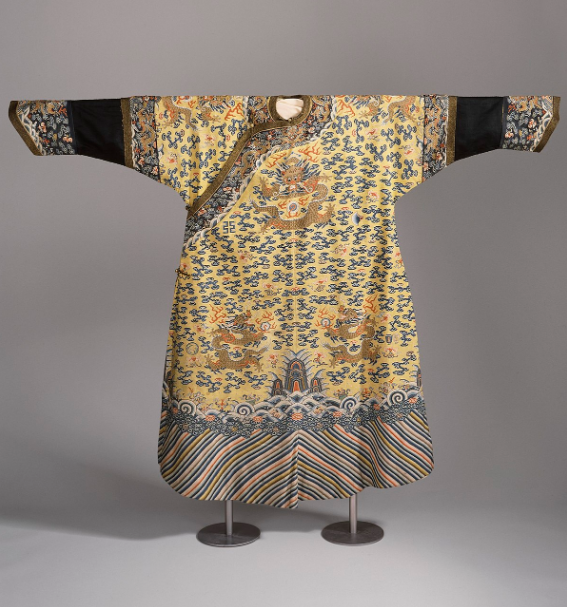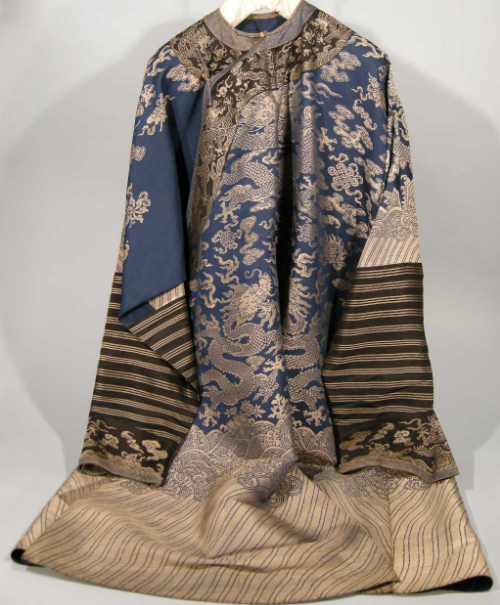Historical Origins of the Dragon Robe
Early Use in Chinese Dynasties
The dragon robe, a symbol of imperial authority, first emerged in early Chinese dynasties. Initially, it served as a regal garment exclusively for emperors, symbolizing their supreme power and divine connection. This exclusivity underscored the sacrosanct status of the emperor in ancient Chinese society, as the dragon was a revered symbol associated with strength and good fortune.
Evolution of the Dragon Symbol in Textiles
Over time, the depiction of dragons in textile art evolved significantly. From simplistic designs in the early dynasties, the dragon motif became more intricate and stylized, reflecting advancements in textile techniques and artistic expression. The evolution of this symbol in robes mirrored broader changes in Chinese art and culture, showcasing the dynamic nature of symbolic representation in textiles.
The dragon robe’s journey through history highlights its deep-rooted significance in Chinese culture. Each adaptation and change in design not only marked a new era in textile art but also mirrored the shifting dynamics of power and cultural values in China. For a deeper dive into the history and evolution of the dragon symbol in Chinese textiles, exploring historical fashion resources can provide detailed insights and context.

Symbolism in Imperial Power and Authority
Representation of the Emperor’s Divine Right
The dragon robe, intricately adorned with dragon motifs, served as a striking symbol of the emperor’s divine authority. Each dragon, meticulously embroidered, represented the emperor’s wisdom and power, echoing the revered mythological creature’s characteristics. This regal attire was not just a garment; it was a powerful statement of the emperor’s unique, heaven-bestowed mandate to rule.
Use in Imperial Ceremonies and Rituals
The robe’s significance shone brightly in imperial ceremonies and rituals. During grand events like the Lunar New Year or imperial weddings, the emperor donned this majestic garment, enhancing the solemnity and grandeur of the occasion. The dragon robe, with its splendid designs, not only added a visual splendor to these events but also served as a constant reminder of the emperor’s supreme power and the continuity of his dynasty.
The dragon robe’s symbolism in reflecting imperial power and authority is deeply rooted and multifaceted, representing a complex interplay between fashion, symbolism, and governance. It stands as a resplendent symbol of the emperor’s unparalleled position in the cosmic order. To explore its imperial significance further, consulting comprehensive resources on Chinese imperial clothing can offer more in-depth insights and historical context.
Cultural Significance and Meanings
The Dragon as a Symbol of Prosperity and Strength
In Chinese culture, the dragon symbolizes prosperity, strength, and good fortune. Embroidered on robes, it embodies these qualities, representing the wearer’s power and noble status. The dragon’s depiction on imperial robes is not mere decoration; it’s a powerful symbol of the emperor’s ability to bring prosperity and maintain strength in the realm.
Variations in Symbolism Across Different Regions
The symbolism of the dragon varies across different regions of China. In some areas, it’s seen as a rain-bringer, crucial for agriculture, while in others, it represents imperial authority and protection. These regional variations highlight the dragon’s versatility as a cultural symbol, adapting to local beliefs and traditions.
The dragon robe’s cultural significance extends beyond its aesthetic appeal, symbolizing a myriad of virtues and powers. It reflects the rich tapestry of Chinese culture, where symbols carry deep meanings and influence societal values. For a deeper understanding of the dragon’s symbolism across different regions, resources on Chinese cultural symbols provide extensive insights.
Artistic and Design Elements
Symbolic Significance of Colors and Patterns
In the dragon robe, colors and patterns are rich with symbolism. Yellow, often the dominant color, signifies royalty and the earth, aligning the emperor with the center of the universe. The dragon patterns, interwoven with clouds, waves, and mountains, depict a cosmic connection, symbolizing the emperor’s role as a mediator between heaven and earth.
Interpretation of Dragon Imagery in Robe Design
The dragon imagery in robe design is meticulously crafted, each detail laden with meaning. The dragon’s posture, number of claws, and direction of motion all carry specific implications. For instance, a five-clawed dragon represents the emperor, while lesser numbers indicate lower ranks. The dragon facing upward symbolizes aspiration for greater heights and blessings from the heavens.
The artistic and design elements of the dragon robe are not just visually striking but deeply symbolic, reflecting the intricate interplay between art, power, and spirituality in Chinese culture. Every color, pattern, and image weaves a narrative of cosmic balance and imperial authority. For further exploration of these design elements, historical texts on Chinese imperial clothing offer a wealth of information.
Influence on Chinese Fashion and Art
Impact on Traditional Chinese Clothing
The dragon robe’s influence on traditional Chinese clothing is profound. Its design principles have inspired numerous garments, with dragon motifs often appearing in formal wear, signifying status and elegance. The use of luxurious fabrics and intricate embroidery in traditional attire owes much to the legacy of the dragon robe, symbolizing a blend of beauty, power, and cultural identity.
Depiction in Classical and Modern Chinese Art
In both classical and modern Chinese art, the dragon robe is a recurring theme, symbolizing imperial authority and cultural heritage. Classical artworks often depict historical figures in these robes, emphasizing their power and status. Modern artists reinterpret the dragon robe, using it to explore themes of identity, history, and the blending of past and present in Chinese culture.
The dragon robe’s impact on Chinese fashion and art extends beyond its historical origins, influencing contemporary design and artistic expression. It remains a symbol of cultural pride and heritage, inspiring new generations of artists and designers. For an in-depth understanding of its influence, studies in Chinese fashion and art history can provide comprehensive insights.

Contemporary Relevance and Adaptations
Use in Modern Fashion and Design
In modern fashion and design, the dragon robe inspires contemporary apparel, blending traditional motifs with new styles. Designers often reinterpret its iconic elements, incorporating dragon patterns into modern garments. This fusion creates a unique aesthetic that resonates with both the rich heritage of the past and the dynamic trends of the present, symbolizing a bridge between history and modernity.
The Dragon Robe as a Cultural Icon in Contemporary Society
In contemporary society, the dragon robe transcends its original function, emerging as a potent cultural icon. It frequently appears in media, fashion shows, and cultural exhibitions, symbolizing Chinese heritage and artistic excellence. This enduring appeal underscores the robe’s significance as a symbol of cultural identity and pride, reflecting the ongoing reverence for traditional symbolism in modern contexts.
The dragon robe’s contemporary relevance and adaptations highlight its enduring impact on fashion and culture. It continues to inspire designers and artists, serving as a testament to the lasting influence of traditional symbols in today’s world. For further exploration of its role in modern fashion and society, resources on contemporary Chinese fashion offer valuable insights.